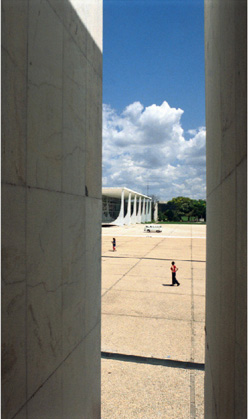Place It!
The Square of the Three (Governmental) Powers – Praça dos Três Poderes– in Brasilia is the centrepiece or cockpit of the capital of Brazil, laid out in the form of an aeroplane. The design of urban planner Lúcio Costa, that became famous as the ”Plano Piloto”, was the winning project in the competition for new foundation of the capital of Brazil in 1956.
During the presidential election campaign in 1955, Juscelino Kubitschek made implementation of Brasilia the central issue of his election campaign. For the president, who was inaugurated in 1956, and for the architect Oscar Niemeyer, who was commissioned to execute the project, the expressive design in the shape of a bird, an aeroplane or a woman symbolised the ambitious undertaking of establishing the economically up-and-coming country in the history of modernism with a new capital city and government seat and enabling it to assume a leading role in the new post-war world order as a nation-state.
For a short time, Brasilia vied with Washington as the better example of newly founded government cities. But the change in geopolitical power relations and the USA’s claim to exclusive power suppressed the development of Latin American states.
The administrative and representative buildings of the government city were built on a cross-shaped ground plan along the monumental long axis. The cross axis was made up by fanned-out Superquadras that served as housing areas for civil servants and their families.
The Square of the Three Powers is the ideological and symbolic centre on the east edge of the government axis: it is formed by the Palace of the Executive, the Palace of the Supreme Court and, slightly set apart, the Congress. A monument to democracy was later added to the ensemble.
The processes of modernisation pushed ahead by Juscelino Kubitschek were brought to an abrupt political end in 1964 by a coup and the subsequent military dictatorship. However, the vast building progress in the new capital, which was also accompanied by financial scandals, had advanced so far that there was now no stopping its political goal – to restructure the country by relocating the capital city from Rio de Janeiro to inland Brasilia.
The formal open space of the square, structured from by architecture of this top-down modernisation process, was temporarily worked by ice-cream, drink and souvenir vendors with selling spaces and kiosks. However, this alternation of dominance and subordination, of suppression and informal subversion was not to last. In the meantime – in keeping with modern logics of order and discipline – the square has been emptied again.
|
|

